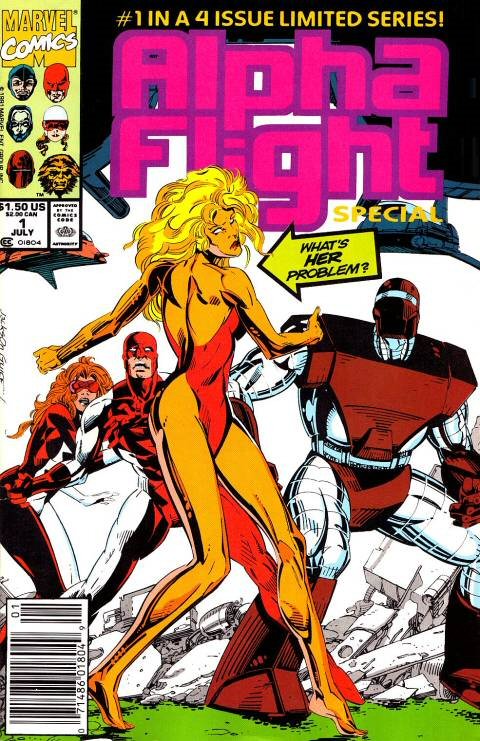 Alpha Flight Special (1st series) – (1991)
Alpha Flight Special (1st series) – (1991)
In 1991, Marvel published what would, at first glance, be an Alpha Flight mini-series named Alpha Flight Special. While technically a mini-series, it was in fact a reprint series that was published in conjunction with the very issues it was reprinting. By the time it was about to reach its hundredth issue, Alpha Flight had long been a direct market only title, which meant that it was only sold in comic book shops and not in the newsstand market. Perhaps wanting to get the anniversary story in a more high-profile market, Marvel released these four issues as Alpha Flight Special #1-4. Each issue was published the month after the issue it was reprinting was published, making it unique in the comics industry.
| Writers | Artists |
|---|---|
|
|
Alpha Flight Special (2nd series) – (1992)
In the summer of 1992, Marvel published a stand-alone special, titled simply Alpha Flight Special. Although not in the indicia as such, most fans refer to this as “First Flight,” the name given to the 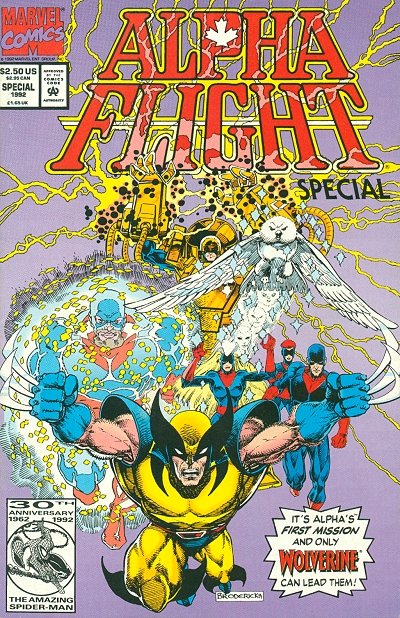 story within. According to the credits, the story was plotted and co-scripted by Scott Lobdell, who was helped by Simon Furman. Given that this was published right around the time of Lobdell’s abrupt exit from the core title (which then went to Furman), most likely Lobdell was partially through writing it when he was given notice of the editorial change and the completion of the project was given to Furman.
story within. According to the credits, the story was plotted and co-scripted by Scott Lobdell, who was helped by Simon Furman. Given that this was published right around the time of Lobdell’s abrupt exit from the core title (which then went to Furman), most likely Lobdell was partially through writing it when he was given notice of the editorial change and the completion of the project was given to Furman.
The story itself was a bit ambitious, taking place not only prior to Alpha Flight #1 but before “Weapon Alpha’s” first appearance in X-Men (1st series) #109. This allowed use not only of a still living James Hudson but a Canadian-employed Wolverine, who had not yet been recruited by Professor X. This “prequel” also depicted pre-Alphan versions of Snowbird, Shaman and Sasquatch, pre-Beta/Omega member Smart Alec and new characters of Stitch, Groundhog, and Saint Elmo. Apparently, there had been plans for a follow-up special called “The Bloodling,” but it was never published, again most likely due to the departure of Lobdell.
| Writers | Artists |
|---|---|
|
|
Northstar (1994)
Two months after the final issue of Alpha Flight's first series was released, the first ever limited series featuring an Alpha Flight related character was published. Authored and illustrated by the same creative team that helmed the final days of the first Alpha Flight series, this four-issue  adventure picked up on threads already hinted at in the Alpha Flight's final issue – Northstar being unhappy with the government shutting down Department H. Due to his high profile within the Marvel Universe, he also became the target of a criminal who didn’t like who he was – gay and mutant. Northstar's first solo adventure also touched on his own criminal terrorist past, as part of the Quebec séparatiste movement. The series picked-up threads established elsewhere in the Marvel Universe by bringing in Weapon P.R.I.M.E. These mostly-Canadian characters previously appeared in early issues of X-Force, and operated from the mysterious Department K. It seemed that moves were being made to establish them as Canada's new super-team, as Guardian even met with Weapon P.R.I.M.E's leader, Tigerstryke, to give him some advice. Much like the creative team, Weapon P.R.I.M.E faded into obscurity after this mini-series, and both Simon Furman and Dario Carrasco left Marvel soon after.
adventure picked up on threads already hinted at in the Alpha Flight's final issue – Northstar being unhappy with the government shutting down Department H. Due to his high profile within the Marvel Universe, he also became the target of a criminal who didn’t like who he was – gay and mutant. Northstar's first solo adventure also touched on his own criminal terrorist past, as part of the Quebec séparatiste movement. The series picked-up threads established elsewhere in the Marvel Universe by bringing in Weapon P.R.I.M.E. These mostly-Canadian characters previously appeared in early issues of X-Force, and operated from the mysterious Department K. It seemed that moves were being made to establish them as Canada's new super-team, as Guardian even met with Weapon P.R.I.M.E's leader, Tigerstryke, to give him some advice. Much like the creative team, Weapon P.R.I.M.E faded into obscurity after this mini-series, and both Simon Furman and Dario Carrasco left Marvel soon after.
| Writers | Artist |
|---|---|
|
|
Alpha Flight (2nd series) – (1997-1999)
In the three-year period between the first and second Alpha Flight series, the only Alpha Flight character who went on to any notable form of success outside of Alpha Flight was Wild Child. Reverting to his more recognizably feral form, Wild Child was quickly brought into the X-Factor book as a new member of the U.S. government's mutant team. Guardian and Vindicator had appeared in a few issues of Wolverine's solo book, Shaman appeared in one issue of Over the Edge (one of Marvel's 99¢ comics) and Puck guest-starred in Domino's solo miniseries. Northstar and Aurora returned in an issue of X-Factor where they reunited with Wild Child, before Aurora became a member of Havok's new Brotherhood of Mutants and appeared in several issues of X-Man. Perhaps the most important appearance during this period was Sasquatch, who, in Generation X (1st series) #19, was shown to be working still at Department H. The sprawling Department H complex was now depicted as abandoned and in ruin, echoing the current state of Marvel's use of Alpha Flight. But Talisman? Persuasion? Manikin? Nemesis? Wyre? Windshear? The majority of Alpha Flight's unique characters fell deep into character limbo, some taking decades before they would ever appear again – and some who have never made a return.
However, the Marvel Universe was a much different place in 1997 than it was in 1994. The majority of the American-based super-heroes were involved in the “Onslaught” event which saw several of Marvel's most popular and recognizable characters – such as Captain America, Iron Man, Thor and the Fantastic Four – transported to a new pocket universe where they existed as “Heroes Reborn.” With the adventures of these heroes taking place in this pocket reality and not in the main 616 universe, Marvel looked to the past to fill the void. Mid-tier villains were disguised as heroes in the new Thunderbolts comic, while classic heroes Luke Cage and Iron Fist returned as part of a new Heroes for Hire team. Ka-Zar was given his third solo outing with a new series, Wolverine’s supporting cast member Maverick was upgraded to star of his own solo title and, finally, Canada's premiere super-heroes were given a new lease on life. Promos for the title billed them as “Their nations only heroes... the world's only hope” – a daunting tagline for any team of heroes indeed. The creative team to relaunch the title was Wildstorm alumni Steve T. Seagle and the late Scott Clark, as the book's writer and penciler respectively, with Seagle also writing Uncanny X-Men at the same time.
Technically, the Alpha Flight series returned with the #minus1 special, a single-issue gimmick running through most other Marvel Comics released in July 1997, as part of a “flashback month.”  The idea was to have a standalone story that detailed stories never shown before that took place early in the characters’ lives. In Alpha Flight's case, it was the wedding of James and Heather Hudson, which had been referenced many times before, but was now seen and fleshed out in more detail. Of course, Wolverine and Puck were in the story, and several new concepts that would be major plot points in the main series were established. These included introducing two future team members, half-brothers Jared and Adrian Corbo, as children. Although Heather was a central character, she was depicted as she once was from the beginning of the Byrne era: wearing wide-glasses and a mousy, devoted housewife of a brilliant scientist – a far cry from one of the most powerful women in Canada that she eventually became as long-time leader of Alpha Flight over the course of the first series.
The idea was to have a standalone story that detailed stories never shown before that took place early in the characters’ lives. In Alpha Flight's case, it was the wedding of James and Heather Hudson, which had been referenced many times before, but was now seen and fleshed out in more detail. Of course, Wolverine and Puck were in the story, and several new concepts that would be major plot points in the main series were established. These included introducing two future team members, half-brothers Jared and Adrian Corbo, as children. Although Heather was a central character, she was depicted as she once was from the beginning of the Byrne era: wearing wide-glasses and a mousy, devoted housewife of a brilliant scientist – a far cry from one of the most powerful women in Canada that she eventually became as long-time leader of Alpha Flight over the course of the first series.
Much as Byrne had done at the beginning of the first series, Seagle depicted Alphans that had moved on from super-heroics. Heather, for instance, was now a florist, much removed from the leader and tactician she had once been. Puck likewise was bored with life and looked for any excuse he could to see Heather. Much to their surprise, their civilian lives came to an end when both were forcibly abducted by agents of a revived Department H, now headed by General Clarke, a morally 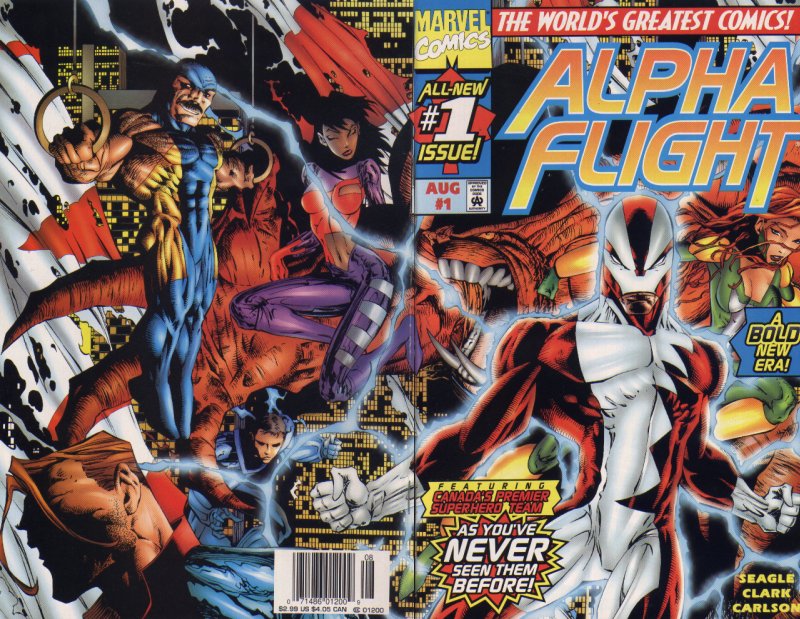 dubious character from the first series. Not only had Department H been started again, it was clearly fully funded, with numerous staff who would serve as supporting characters throughout the series. Most notable among them was Dr. Horatio Huxley, who acted as an antagonist through the title’s run. The machinations of Huxley, Clarke and this mysterious new Department H were central to the book's plot, and at times took precedent over its main characters, the heroes of Alpha Flight.
dubious character from the first series. Not only had Department H been started again, it was clearly fully funded, with numerous staff who would serve as supporting characters throughout the series. Most notable among them was Dr. Horatio Huxley, who acted as an antagonist through the title’s run. The machinations of Huxley, Clarke and this mysterious new Department H were central to the book's plot, and at times took precedent over its main characters, the heroes of Alpha Flight.
It was quickly made clear to Heather and Puck that they were back as members of Alpha Flight, whether they wanted to be or not. Joining them would be a few old Alphans, as well as some new ones. The returning members would be Madison Jeffries, minus both his Box armor and his wife Diamond Lil, whose absence seemed more than odd. Sasquatch was more puzzling, as he never reverted to his human form and his Sasquatch form was wild, beastly and incapable of general communication. He had apparently been found wandering through the wilderness and his current appearance was presumed to be the result of Walter Langkowski experimenting on himself. He was only held in check by one of the new recruits, a young woman named Murmur, who could influence people simply by touching them. A second recruit was a cyborg named Manbot, who was apparently comprised of the remains of the Box armor and a Department H agent called Bernie Lachenay. The remaining two new members were the aforementioned Corbo brothers, now calling themselves Radius and Flex, the former wielding a force field and the latter possessing limbs that could turn into razor-sharp metal. Most shockingly, rounding out the team would be none other than Heather’s ex-husband, James Hudson – who had been reverted in age to about nineteen, an apparent side-effect following the temporal regression and removal of his alien implants.
All of this was necessary, as Canada was being blackmailed by the terrorist organization called Zodiac, who threated a devastating and deadly chemical attack on Vancouver. Even though the government of Canada had turned their back on them in the past, neither Heather nor Puck would do that in turn to their country. Heather reluctantly agreed to adopt a new tech-suit, wielding powers different than her old one. As Mac was now using the name Guardian again, Heather reverted to the name of Vindicator. Together, the new Alpha Flight succeeded in their mission. Once completed, Heather and Puck declared their intention to leave, only to be shot in the back with tranqs and then subjected to brainwashing to make them believe they wanted to stay.
So, with this first issue, Seagle had set his tone for his new Alpha Flight series. The team was back, though working under a Department H that viewed the Alphans as pawns to be used. In fact, in the first issues it was revealed that the cyborg Manbot was a spy for the Department. General Clarke and Department H’s manipulation of the Alphans would be a running subplot throughout the series. Seagle also had a few other surprises. In time, Puck would learn that this Sasquatch was in fact not Walter Langkowski, but a mythological beast captured by Department H. However, this fact was immediately “forgotten” by Puck, due to the department’s brainwashing. Along the way, Seagle did his best to explore the new characters he had introduced.
Along with these new additions to the lore, Seagle was also careful not to ignore Alpha Flight's rich past. Although the Master of the World (arguably Alpha’s greatest villain) never made an appearance (he was being used in the Heroes for Hire series), synthezoid replicas of him were used to test the new Alpha Flight in combat. One-time Alpha Flight villain Mesmero returned for a two-issue storyline, which saw him pit the veteran and rookie members of the team against each other. A new Beta Flight was sort-of established when a young girl called Lilli was taken from the same orphanage in which Radius and Flex grew up. After this, she was left to wander Department H while being assured that she would one day join Alpha Flight. A meeting between Alpha Flight and the X-Men occurred, with Alpha Flight being sent after Wolverine when they were shown doctored video footage of him apparently killing Madison Jeffries (who was really kidnapped by Zodiac in their first mission, but the team was forced to forget). Alpha Flight (2nd series) #9 depicted Alpha Flight's point of view of this encounter, while Uncanny X-Men (1st series) #355 showed the X-Men's. The team even enjoyed a visit to the Microverse and teamed-up with the Micronauts.
By the time Alpha Flight (2nd series) reached its twelfth issue, a number of plotlines came together in an epic double-sized issue which saw the new Zodiac attack Department H in search 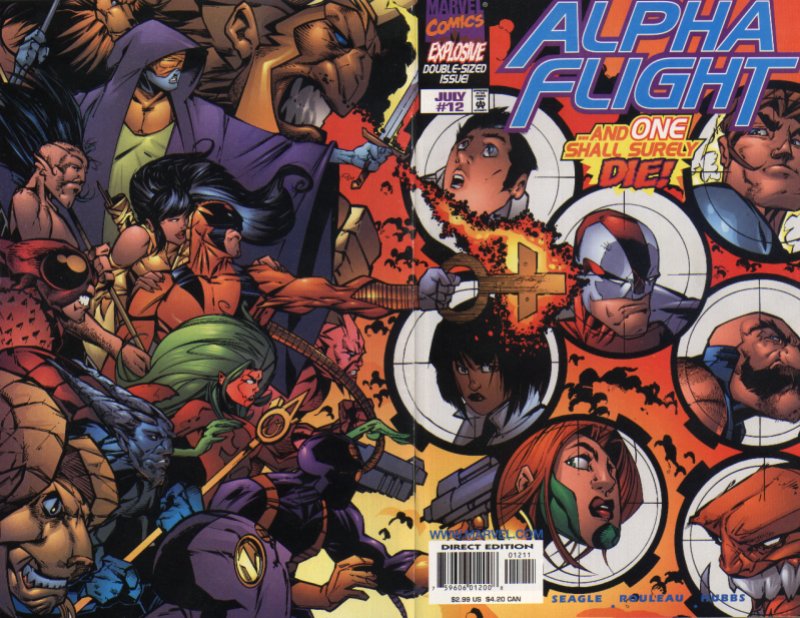 of the Nth Projector. Naturally, there were two Gemini in the Zodiac, one referred to being of flesh, and the other of steel. While Madison was unmasked during the confrontation, the other Gemini was not. The reference to flesh and steel could be interpreted one of two ways: Madison being of steel and a resurrected Scramble (his brother) of flesh, or that Madison was of flesh, and the other Gemini was of steel, a robot construct controlled by Madison. An interesting mystery that was unfortunately never resolved. The issue also harkened back to the twelfth issue of the original series and even had an homage cover to reflect it. There was even a mirrored scene with Heather attempting to fix a deadly malfunction in her own Vindicator suit before it killed her, as had happened with her husband so long ago. Fortunately, unlike her husband, she succeeded and the Alphan that died in the issue turned out to be the Sasquatch beast. Although not an Alphan himself, General Clarke also died, though in a surprisingly heroic manner for someone who has spent his life trying to control super-heroes. This double-sized issue also saw the arrival of new permanent artist, Duncan Rouleau, replacing Scott Clark. Rouleau had previously penciled several issues of X-Factor, a Venom mini-series and some fill-in issues at Marvel.
of the Nth Projector. Naturally, there were two Gemini in the Zodiac, one referred to being of flesh, and the other of steel. While Madison was unmasked during the confrontation, the other Gemini was not. The reference to flesh and steel could be interpreted one of two ways: Madison being of steel and a resurrected Scramble (his brother) of flesh, or that Madison was of flesh, and the other Gemini was of steel, a robot construct controlled by Madison. An interesting mystery that was unfortunately never resolved. The issue also harkened back to the twelfth issue of the original series and even had an homage cover to reflect it. There was even a mirrored scene with Heather attempting to fix a deadly malfunction in her own Vindicator suit before it killed her, as had happened with her husband so long ago. Fortunately, unlike her husband, she succeeded and the Alphan that died in the issue turned out to be the Sasquatch beast. Although not an Alphan himself, General Clarke also died, though in a surprisingly heroic manner for someone who has spent his life trying to control super-heroes. This double-sized issue also saw the arrival of new permanent artist, Duncan Rouleau, replacing Scott Clark. Rouleau had previously penciled several issues of X-Factor, a Venom mini-series and some fill-in issues at Marvel.
Between developing his own new characters, pushing forward with Heather and Puck's stories, keeping track of a dozen or so supporting characters within Department H and managing a large number of mysterious plots, Seagle slowly began to re-introduce more of Alpha Flight's classic characters. One was Northstar, who was on a mission to find Aurora, whose mental instability had become extremely dangerous for her. Diamond Lil showed up at Department H looking for her missing husband only to be captured by Dr. Huxley and shoved into one of his labs where he began experimenting on her (but not before somehow recognizing the young Lilli who she bumped into – another plot point never resolved). Finally, Walter Langkowski (the true Sasquatch) showed up, along with someone claiming to be James Hudson – the real Guardian. Along with Shaman, these classic Alphans eventually regrouped in preparation for returning to and confronting the shadowy Department H.
However, that dark, nefarious Department H was suddenly becoming no more. With General Clarke's death, a new administrator arrived at Department H. Known simply as Mr. Gentry, he embarked on a clean sweep of Department H, his mission, to ensure that Department H and its staff were supporting the heroes of Alpha Flight to protect their nation. Answers to some mysteries were starting to come to light, and the brainwashing of Heather and Puck ceased. Issue #17 even saw Alpha Flight go head-to-head with the Japanese super team Big Hero Six, after Sunfire had spent some time throughout this series at Department H and occasionally assisting Alpha Flight.
Unfortunately, despite the long-game intentions that Steve T. Seagle clearly had for the book, apparently fans did not overly take to this new era of Alpha Flight. Compounded with Marvel returning their focus to the likes of Captain America, Iron Man and Thor who had returned from the pocket dimension as part of the “Heroes Return” storyline, Alpha Flight (and most of the other titles Marvel re-launched around the same time) was cancelled. This Alpha Flight series ended 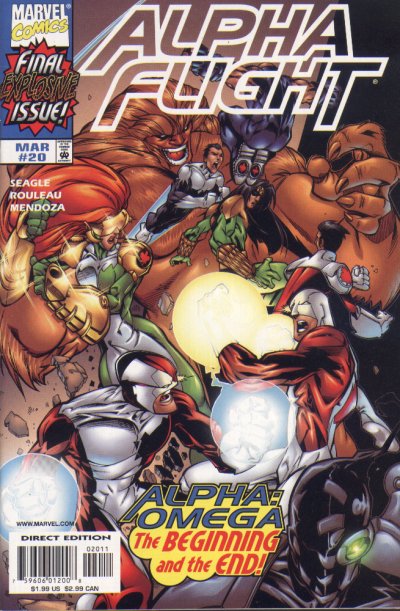 with an epic three-part storyline across issues #18-20, which saw the original Alphans battle the new Alphans before teaming up to save Canada from a mysterious new Weapon X. This Weapon X was a tourist from New Zealand captured by Dr. Huxley while visiting Department H and experimented on with a deadly bacteria called Thetagen-24. This was the same bacteria responsible for Aurora's mental state and used on Diamond Lil (whom Alpha Flight eventually discovered and rescued). A number of plots were wrapped up, including the revelation that either the 19-year-old Guardian or the older Guardian was the original – but Mr. Gentry refused to state which. However, many, many more plots remain unresolved (and to this date). The final page of Alpha Flight (2nd series) #20 included a line by Mr. Gentry saying that Department H would never allow someone to write stories about Alpha Flight, as if stating some sort of curse that would plague Alpha Flight in the years to come.
with an epic three-part storyline across issues #18-20, which saw the original Alphans battle the new Alphans before teaming up to save Canada from a mysterious new Weapon X. This Weapon X was a tourist from New Zealand captured by Dr. Huxley while visiting Department H and experimented on with a deadly bacteria called Thetagen-24. This was the same bacteria responsible for Aurora's mental state and used on Diamond Lil (whom Alpha Flight eventually discovered and rescued). A number of plots were wrapped up, including the revelation that either the 19-year-old Guardian or the older Guardian was the original – but Mr. Gentry refused to state which. However, many, many more plots remain unresolved (and to this date). The final page of Alpha Flight (2nd series) #20 included a line by Mr. Gentry saying that Department H would never allow someone to write stories about Alpha Flight, as if stating some sort of curse that would plague Alpha Flight in the years to come.
Following the book's cancellation Steve T. Seagle revealed some of his plans had the book continued. In #18, Flex had announced that he had discovered who his father was (a mystery that began earlier in the series), but the name of his father was not made known to the readers – that being Wolverine. Similarly, despite Mr. Gentry remarking that one of the two Guardians was the original and the other a clone, this was not the actual intention. Mr. Gentry himself was supposed to be revealed as the real James MacDonald Hudson, and the others both clones. While there is still the slight chance that Wolverine may be confirmed as being Flex's father, any further stories involving clones of Guardian seem highly unlikely.
About six months after the final issue of Alpha Flight (2nd series), Alpha Flight returned in a two-part story by Erik Larsen and Eric Stephenson, Wolverine (2nd series) #142-143 which quickly established the classic Alpha Flight members of Guardian (the older one), Sasquatch, Shaman, Puck, Northstar and Aurora as the new Alpha Flight team. Heather Hudson was now their liaison, and the new characters from Seagle's Alpha Flight run (Radius, Murmur, Flex, Ghost Girl, Manbot, and the 19-year-old Guardian) were established as a new Beta Flight. Across the two issues, the writers killed off the 19-year-old Guardian after confirming he was the clone of the older, and resurrected Snowbird, with no reference to how this was even possible. In the years that would follow, the core Alpha Flight roster would consist of Guardian and Vindicator, Sasquatch, Snowbird, Shaman and Puck. Northstar and Aurora were unavailable, as they were frequently used by other areas of the Marvel Universe, but writers seemed to think that the original/classic members were the characters readers wanted stories about. The team even appeared across Wolverine (2nd series) #171-174 and #179-180 in supporting capacity, with clear intentions that this was Alpha Flight, even going as far as to establish new stories for them – a pregnancy for Vindicator and Guardian, and an explanation as to Snowbird's resurrection (“the gods did it”). Long gone now were the cloak and dagger of Seagle's Department H. Any writer wanting to use Alpha Flight had to use this classic lineup... for now.
Despite Frank Tieri and Matt Nixon writing genuinely interesting stories for Alpha Flight as supporting characters in Wolverine's solo series, any chance at longevity for this was not to be, as Wolverine's solo series was cancelled with #189. With Northstar having been recently integrated into the X-Men team in Uncanny X-Men, its writer Chuck Austen picked up on plots established over in the Wolverine series. He resolved the Vindicator pregnancy storyline in X-Men Unlimited (1st series) #45 and then had this restored “classic” team appear in #421-422. He then used Vindicator, Guardian and Sasquatch as antagonists for the Juggernaut in #432-434.
| Writers | Artists |
|---|---|
|
|
